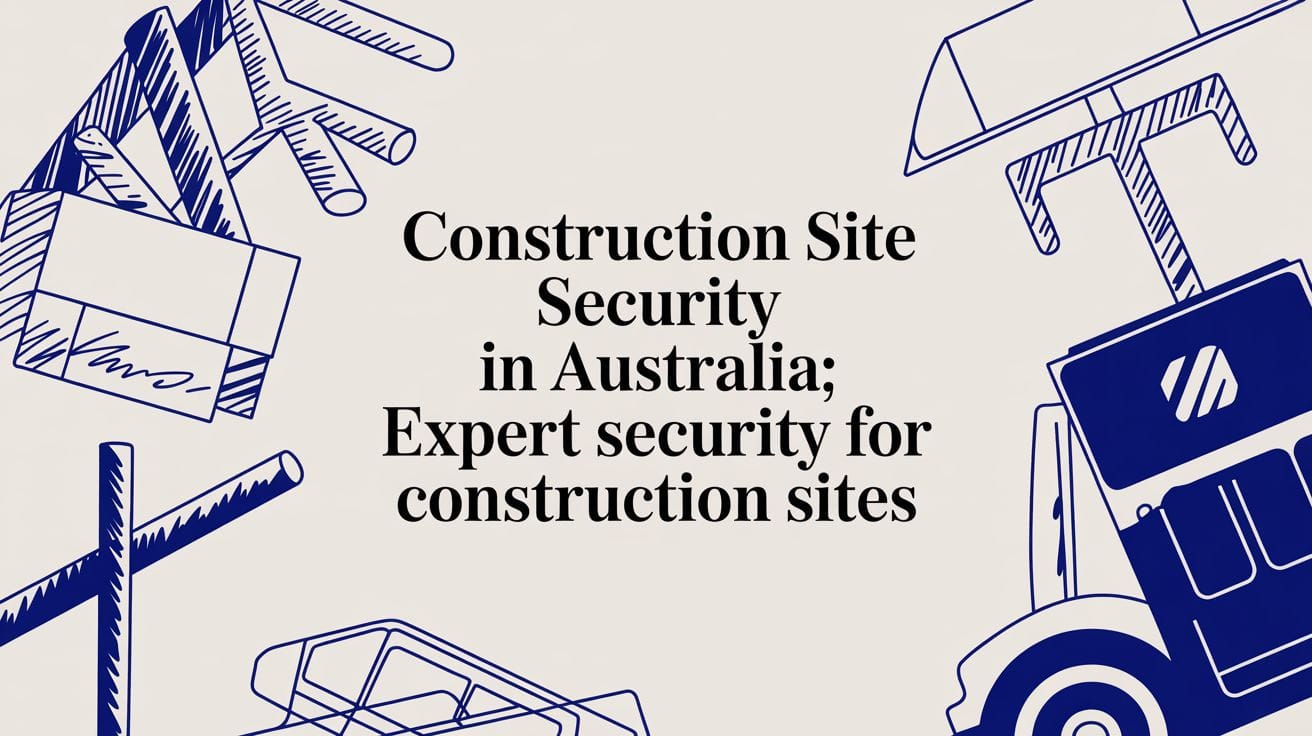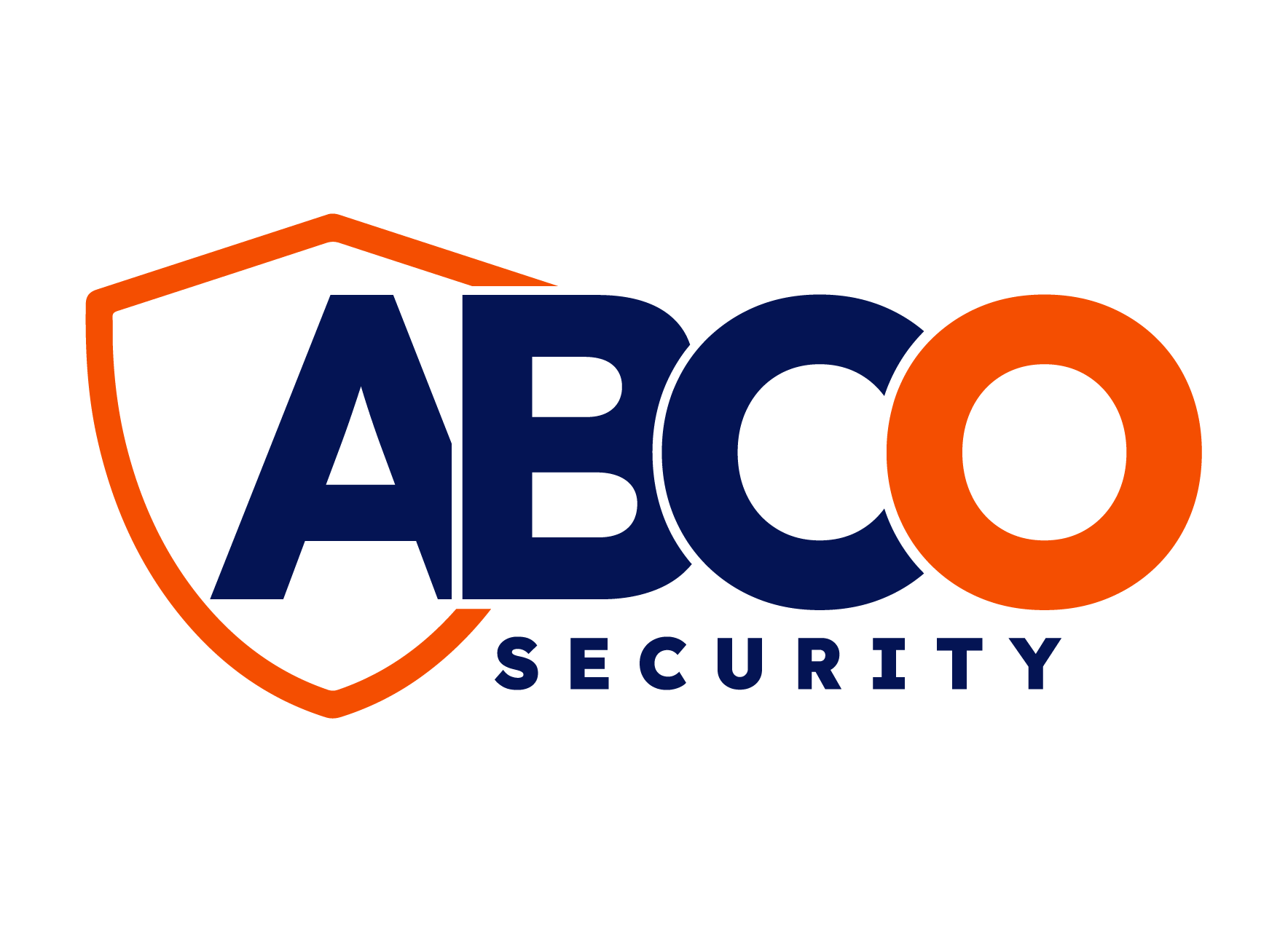
True employee safety in the workplace is more than a compliance task; it is the foundation of a resilient and successful Australian business. Proactively building a secure environment protects your team, enhances your reputation, and directly benefits your bottom line.
Why Employee Safety Is the Cornerstone of Your Business
Fostering a culture of safety is a powerful investment. It requires a shift from a reactive mindset—addressing incidents after they occur—to a proactive one focused on prevention. When your people feel genuinely safe, it builds trust, loyalty, and long-term growth.
This guide provides a clear roadmap for Australian businesses aiming to establish a robust safety framework. We will cover your legal duties under Work Health and Safety (WHS) laws, explain how to conduct effective risk assessments, and show how a professional Security Company Melbourne can create a secure environment.
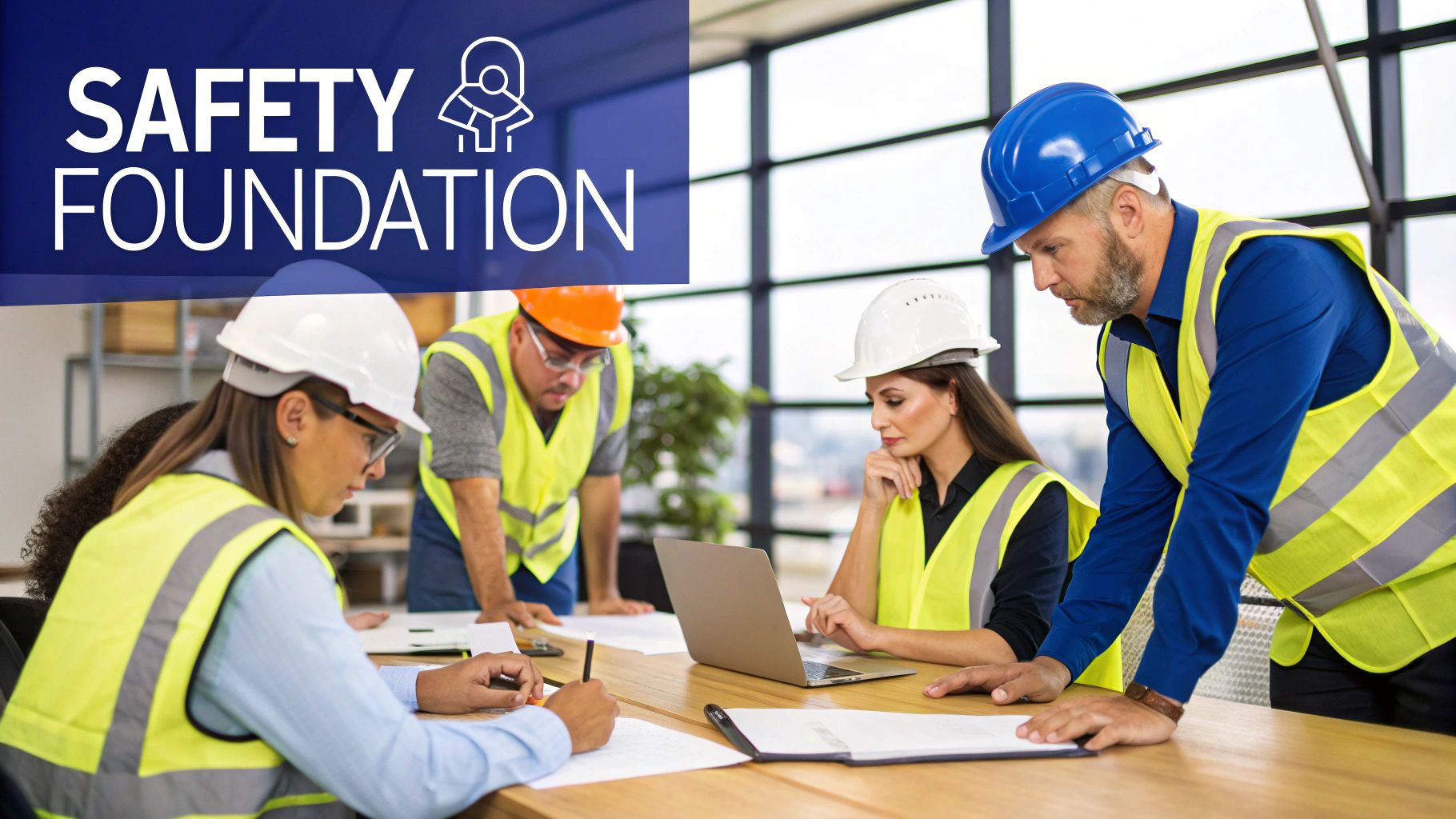
The Core Pillars of a Workplace Safety Program
A strong safety program is built on several interconnected pillars. Each component supports the others to create a protective structure around your people and operations. If one pillar is weak, the entire structure is compromised.
The essential components include:
- Legal Compliance: Understanding your obligations under Australian WHS legislation is non-negotiable. It is the baseline for keeping people safe and avoiding serious penalties.
- Risk Management: This involves systematically identifying potential hazards, assessing their severity, and implementing practical controls to manage them effectively.
- Integrated Security: Using professional services like mobile patrols and alarm monitoring adds a critical layer of protection against internal and external threats.
- Positive Safety Culture: This is the human element—an environment where every individual is engaged, trained, and empowered to prioritise safety every day.
For more information on these fundamentals, you might find this article explaining why safety in the workplace is important for your business helpful.
A holistic approach not only prevents accidents but also boosts productivity and morale across the entire organisation. The table below summarises these core pillars.
Core Pillars of an Effective Workplace Safety Program
A summary of the essential components required to build a comprehensive and compliant employee safety framework within an Australian business.
| Pillar | Description | Key Objective |
|---|---|---|
| Legal Compliance | Adhering to all relevant Australian Work Health and Safety (WHS) Acts, Regulations, and Codes of Practice. | To meet legal obligations, avoid fines, and establish a mandatory minimum standard of care for all employees. |
| Risk Management | A systematic process of identifying workplace hazards, assessing the associated risks, and implementing effective control measures. | To proactively reduce the likelihood and severity of incidents before they occur, creating a safer working environment. |
| Integrated Security | The strategic use of professional security services (e.g., patrols, access control) and systems to protect physical assets and personnel. | To deter external and internal threats, secure the premises, and provide a rapid response to security breaches. |
| Safety Culture | The shared values, beliefs, and attitudes about safety within an organisation, demonstrated through leadership and employee behaviour. | To embed safety as a core business value, encouraging everyone to take personal responsibility for their own and others’ wellbeing. |
Each pillar is crucial. In the following sections, we will explore how to strengthen each one within your business.
Navigating Your Duties Under Australian WHS Law
Understanding your legal duties is the first and most important step toward creating a safe workplace. In Australia, the entire system of employee safety in the workplace is governed by the Work Health and Safety (WHS) Act. This framework outlines a fundamental responsibility for every business.
At the core of the WHS Act is the ‘primary duty of care’. This legally requires any person conducting a business to ensure, so far as is reasonably practicable, the health and safety of their workers and others affected by their operations.
What Does ‘Reasonably Practicable’ Actually Mean?
The term ‘reasonably practicable’ is key to the WHS framework. It means you must do everything you realistically can to ensure health and safety.
This involves balancing the likelihood of a hazard causing harm against the options available to mitigate it. Factors include the availability and suitability of controls and their associated cost.
For example, a frayed electrical cord in a main walkway presents a high risk of a serious incident. The cost to replace it is low, making it ‘reasonably practicable’ to fix it immediately. This logic applies to all risks, from physical hazards to psychosocial issues.
A proactive approach to safety is not about achieving the impossible. It is about taking every reasonable step to protect your people, building a compliant and genuinely caring organisation.
Who is Responsible for Workplace Safety?
WHS law makes it clear that safety is a shared responsibility. While the business holds the primary duty, obligations are spread throughout the organisation.
- Officers (e.g., Company Directors): These leaders have a duty of ‘due diligence’. They must actively ensure the business meets its WHS obligations by understanding risks and allocating sufficient resources.
- Managers and Supervisors: They ensure safety policies are followed on the ground. This includes overseeing safe work systems, correct use of protective gear, and adequate training.
- Workers (Employees and Contractors): Everyone has a duty to take reasonable care of their own safety and not adversely affect the safety of others. They must comply with reasonable safety instructions.
Your Core Duties as a Business Owner
As a business owner, your primary duty of care translates into several concrete actions. These are the non-negotiable pillars of a legally compliant safety program.
You must provide and maintain:
- A Safe Work Environment: Your premises, buildings, and layout must be free from health and safety risks.
- Safe Plant and Structures: All machinery, equipment, and tools must be kept in safe working order.
- Safe Systems of Work: Develop and implement clear, safe procedures for all tasks.
- Adequate Facilities: Provide access to clean toilets, drinking water, and first-aid supplies.
- Information, Training, and Supervision: Ensure workers have the information, training, and supervision needed to perform their jobs safely.
For a deeper dive, a comprehensive guide on navigating Australia’s OHS landscape offers valuable insights. You can also find updates on security standards in our industry news section.
By fulfilling these duties, you are not just meeting a legal requirement; you are building a workplace where your team feels protected, respected, and valued.
The Real Impact of Workplace Incidents in Australia
It is easy to discuss workplace safety in abstract terms, but the data from across Australia paints a sobering picture. Preventable incidents carry a very real human and financial toll, highlighting the deep connection between legal obligations and the fundamental duty to protect your team.
High-Risk Industries and Common Dangers
Some jobs carry a higher inherent risk. National data helps pinpoint where the greatest dangers lie, allowing businesses to focus safety efforts where they are needed most.
This infographic breaks down high-risk sectors, the most frequent incident types, and their associated costs, providing a snapshot of Australia’s current safety landscape.
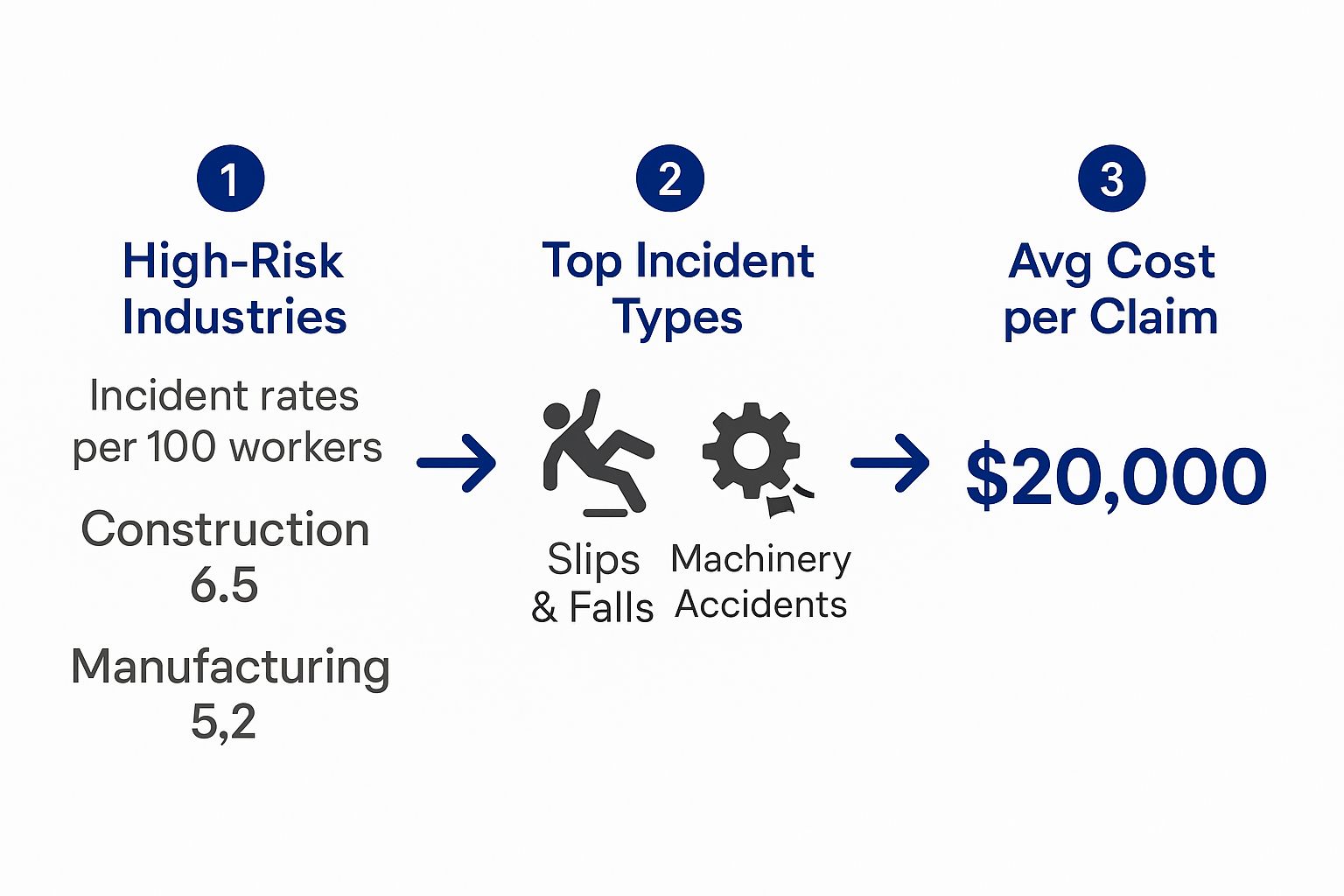
Sectors like construction and manufacturing are hotbeds for incidents, with slips, falls, and machinery accidents driving some of the most expensive claims.
The Human Cost of Getting It Wrong
You cannot put a price on the human cost of a serious workplace incident. A life-altering injury or fatality has a ripple effect that impacts families, colleagues, and the wider community.
Last year, 188 Australian workers died from traumatic injuries at work. A significant portion of these fatalities occurred in the transport, agriculture, and construction sectors.
Vehicle incidents remain the leading cause of fatal injuries, accounting for 42% of deaths, followed by falls from height. These figures underscore the need for targeted safety measures in high-risk environments. You can view a full breakdown in the key work health and safety statistics from Safe Work Australia.
The Financial and Operational Fallout
Beyond the human toll, the business consequences of a workplace incident can be severe and long-lasting. The costs extend far beyond medical bills and compensation.
A single serious incident can halt operations, damage equipment, and cause a nosedive in productivity. Hidden costs, like hiring and training replacement staff, are often even higher than the direct expenses.
A poor safety record can also damage your reputation, making it harder to attract and retain talent, deterring clients, and leading to higher insurance premiums.
Consider the potential financial impacts:
- Direct Costs: Workers’ compensation, medical expenses, legal fees.
- Indirect Costs: Lost productivity, project delays, incident investigation.
- Long-Term Costs: Increased insurance premiums, brand damage, reduced morale.
The Critical Role of Proactive Security
Many risks can be drastically reduced with smart, proactive security. This is particularly true in industries like construction, where unauthorised site access, theft, and vandalism create dangerous conditions for workers.
Professional security is a core component of a strong safety strategy. For example, dedicated construction security controls site access, deters crime, and monitors for safety issues after hours. It maintains a secure and stable work environment, directly contributing to a safer workplace.
Investing in a robust safety program is about protecting your most valuable asset—your people—and ensuring the long-term health of your business.
How to Conduct a Workplace Risk Assessment
A risk assessment is your most powerful tool for preventing incidents. It moves you from reactive problem-solving to a proactive, strategic approach. This process is about building a dynamic system that continuously improves over time.
The process can be broken down into four key stages. By following these steps, any Australian business can build a strong framework for identifying and managing workplace hazards.
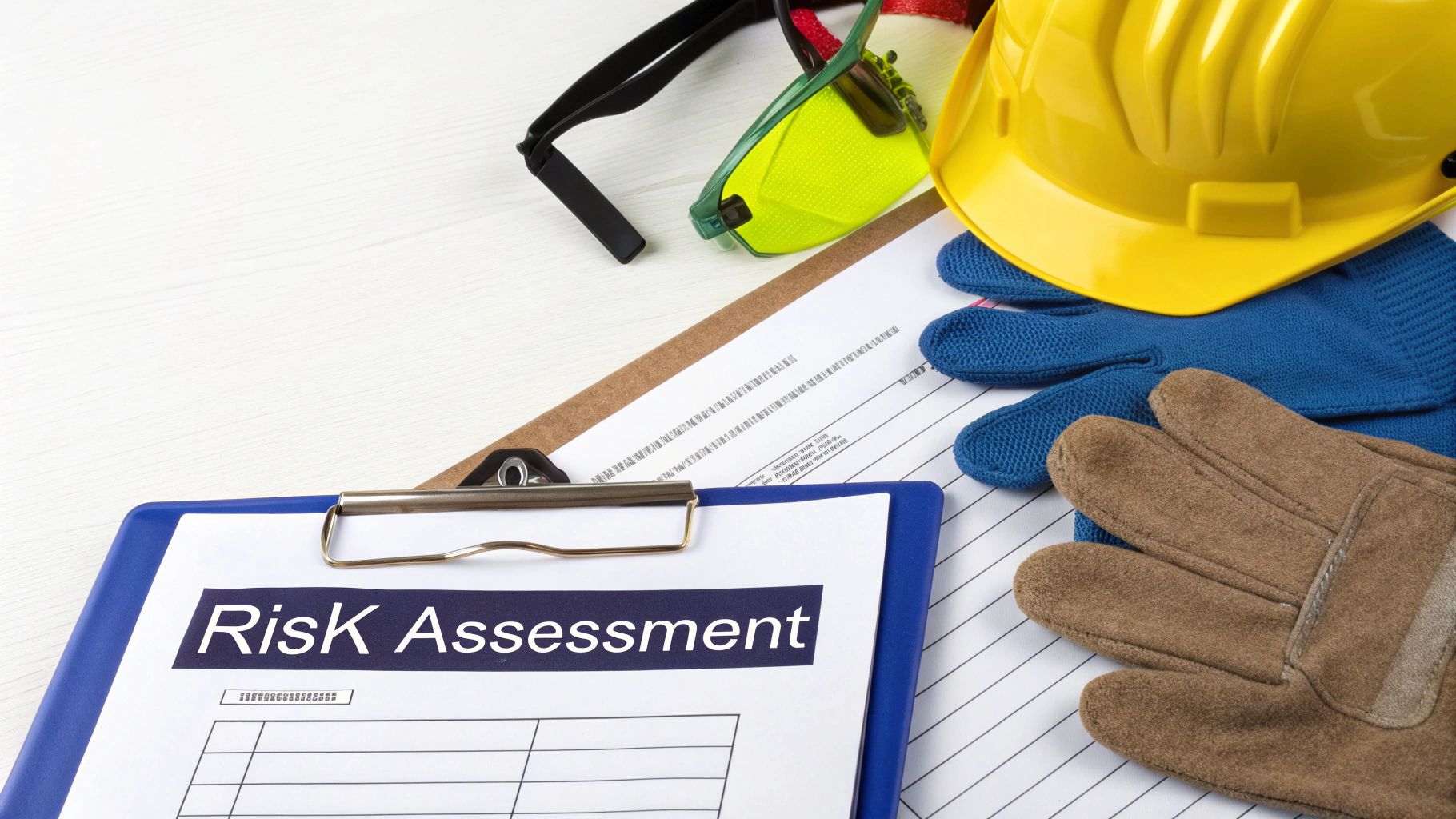
Stage 1: Identify Potential Hazards
First, you must systematically identify anything in your workplace that could potentially cause harm. This requires looking beyond the obvious to consider all risk categories.
To do this properly, you should:
- Walk the floor: Physically inspect every area, observing work processes and equipment use.
- Talk to your team: Frontline workers have invaluable insights into daily risks.
- Check the records: Past incidents and near misses point directly to hazards needing attention.
Remember to identify psychosocial risks—such as excessive workloads, bullying, or burnout—which can be just as damaging as physical hazards.
Stage 2: Assess the Associated Risks
Once you have a list of hazards, assess the risk associated with each. This involves analysing the likelihood of harm occurring and its potential severity. A risk matrix is a useful tool for prioritising your focus.
For example, a wet floor in a busy entryway has a high likelihood of causing a slip, with potentially moderate harm. Faulty wiring on heavy machinery may have a lower likelihood of causing an incident, but the potential outcome is catastrophic. This assessment helps direct resources to the most significant threats first.
Stage 3: Implement Control Measures
With your risks prioritised, it is time to implement controls to eliminate or reduce them. The best-practice model for this is the Hierarchy of Controls, which ranks solutions from most to least effective.
Always aim to start from the top of the hierarchy:
- Elimination: Completely remove the hazard. This is the most effective control.
- Substitution: Replace the hazard with a less risky alternative.
- Engineering Controls: Physically isolate people from the hazard (e.g., machine guards, ventilation).
- Administrative Controls: Change the way people work (e.g., safe work procedures, training).
- Personal Protective Equipment (PPE): Provide workers with equipment like hard hats or gloves. This is the last line of defence.
The goal is always to work from the top of the hierarchy down. Relying solely on PPE means your safety system has a weak link. The best controls are those that do not depend on human behaviour.
Stage 4: Review and Refine Continuously
Workplace safety is never “set and forget.” The final stage is to regularly review your controls to ensure they are effective and adapt them as circumstances change. This creates a cycle of continuous improvement.
Technology like CCTV and alarm monitoring can provide valuable data for these reviews, helping you spot new hazards or confirm existing controls are working.
Review your assessments after an incident, when introducing new equipment, or when work processes change. Staying informed through bodies like ASIAL (Australian Security Industry Association Limited) ensures your safety measures remain aligned with current industry standards.
By embedding this four-stage process into your operations, risk assessment becomes a fundamental part of your workplace culture.
Integrating Security to Enhance Employee Safety
A comprehensive plan for employee safety in the workplace must shield your team from external threats. Professional security services act as a visible deterrent and a rapid response team, creating a genuinely secure environment.
True integration means combining human expertise with smart technology to proactively address vulnerabilities. This ensures all security measures work in harmony to protect your organisation.
Creating a Secure Physical Environment
The physical security of your workplace is the bedrock of employee safety. When staff feel safe, they can focus on their jobs. This begins with controlling access and monitoring the property around the clock.
An integrated approach blends technology with trained personnel for optimal coverage.
- Access Control Systems: These digital gatekeepers ensure only authorised individuals can enter sensitive areas, protecting both people and assets.
- CCTV and Alarm Monitoring: Modern surveillance systems deter threats and, when linked to 24/7 monitoring, trigger an immediate, professional response to any breach.
- Physical Deterrents: Simple measures like clear signage, good lighting, and solid perimeter fencing send a strong message that your property is protected.
The Role of Licensed Security Personnel
Technology cannot replace the critical thinking and on-the-ground presence of a trained professional. A licensed security guard brings skills that automated systems cannot replicate, from de-escalating tense situations to providing a reassuring presence.
A skilled guard can manage access, check credentials, and handle difficult individuals with calm professionalism. They are trained to spot unusual behaviour and intervene before a small problem escalates.
For many organisations, having a professional security guard is an essential part of their safety strategy. They act as ambassadors of security, ready to provide immediate assistance and enforce company policies.
Proactive Security Measures in Action
Proactive security involves anticipating what could go wrong and implementing solutions to prevent it. A well-designed security service addresses your specific vulnerabilities with targeted actions.
For example, a construction site is vulnerable to theft and trespassing overnight, which creates hazards for the morning crew. Regular security patrols are highly effective at deterring this activity.
Some workplace dangers are less obvious. While electrical safety incident notifications in South Australia dropped from 26 to 14 over three years, safety notices for unsafe practices more than doubled. This highlights the importance of proactive safety management. You can learn more about these shocking statistics from SafeWork SA.
An integrated security plan is like a skilled orchestra. Each element—guards, cameras, alarms—plays a distinct role. When they work together under expert direction, they create a seamless and powerful shield of protection.
By combining on-site personnel, mobile patrols, and advanced electronic systems, you build a dynamic defence that adapts to changing conditions, providing robust protection day and night.
Building a Proactive and Positive Safety Culture
Physical barriers and documented rules are crucial, but a world-class safety record is built on culture. A positive safety culture is an environment where protecting each other’s wellbeing is a shared value woven into every decision.
This culture starts at the top. When leadership visibly prioritises safety through their actions and investments, it signals to everyone that safety is a core organisational value. This commitment must be supported by robust training that empowers every employee.
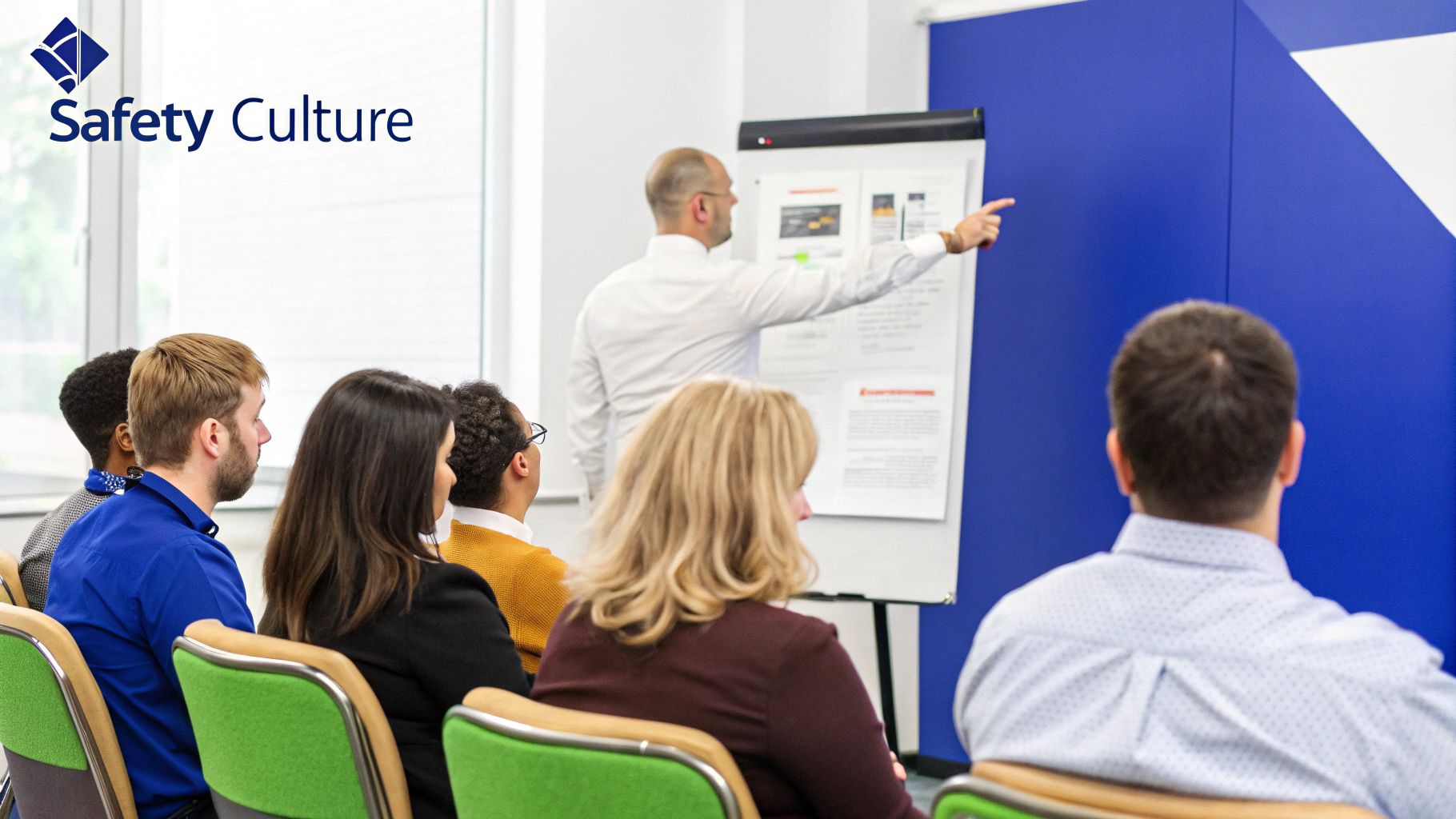
The Foundations of Strong Safety Training
Effective safety training is a continuous process that evolves with your business. A strong program keeps safety knowledge relevant for every team member.
A successful training schedule should include:
- New Hire Inductions: A thorough onboarding covering specific workplace hazards, emergency procedures, and safety policies from day one.
- Hazard-Specific Refreshers: Regular, targeted training on risks like manual handling, chemical safety, or operating new machinery.
- Emergency Response Drills: Practical exercises for situations like fire evacuations or medical emergencies, ensuring everyone knows their role.
Encouraging Employee Participation
A proactive culture must be built from the ground up with active employee participation. When your team feels they have a genuine voice in safety matters, they become your most valuable asset in managing risks.
A positive safety culture is one where every employee feels empowered to report a potential hazard, confident their concern will be taken seriously without fear of reprisal. This psychological safety is the bedrock of a resilient organisation.
Establishing a safety committee with representatives from different departments is an excellent way to formalise this. These committees provide a structured forum for discussing concerns, reviewing incidents, and brainstorming solutions together.
Managing Modern Workplace Challenges
The definition of workplace safety is expanding. Beyond physical dangers, there is a growing awareness of psychosocial risks like excessive job demands, lack of control, and workplace bullying.
The statistics are telling. Of the 146,700 serious workers’ compensation claims in a recent year, 12% were related to mental health issues. The average time off work for these claims is nearly five times greater than for physical injuries. You can explore the full safety statistics for a clearer picture.
Supporting mental health is a critical part of any modern safety framework. A positive culture actively reduces stressors and provides clear support pathways, building a more resilient, engaged, and productive team.
Your Next Step Towards a Safer Workplace
Achieving a genuinely safe workplace is an ongoing commitment, not a one-time project. We have covered the essentials, from legal duties and risk management to integrated security and fostering a safety-first culture. The key takeaway is that a proactive, holistic approach is the only way to effectively protect your people and your business.
A truly safe workplace is built on action, not just policies in a folder. The decisive steps you take today will build a strong foundation for a secure, productive future and demonstrate a genuine commitment to your team’s wellbeing.
Why Partner with a Local Security Expert
Do not leave your team’s safety to guesswork. Navigating Australian WHS laws and unique business risks requires specialised knowledge. Partnering with a local expert who understands the specific challenges in Melbourne and across Australia provides a significant advantage.
An expert security partner can help you:
- Develop a security plan directly informed by your risk assessment.
- Integrate technology with on-site security personnel.
- Ensure full compliance with industry standards and legal duties.
Developing a Customised Security Solution
Every business is unique, so a one-size-fits-all security plan is ineffective. A tailored solution considers your industry, location, operating hours, and specific threats. Whether you need mobile patrols for a construction site or a professional concierge for a corporate office, the right strategy is built around your needs.
A truly secure workplace is one where safety measures are so well-integrated into daily operations that they become second nature. This seamless protection gives both employees and management complete peace of mind, allowing everyone to focus on their core responsibilities.
This collaborative approach ensures your investment delivers real value, creating a safe environment that boosts morale and productivity. It is about building smart, layered protection that works in sync to prevent incidents before they happen.
Investing in your safety program is one of the most critical decisions you can make. The team at ABCO Security is ready to help you take that next step. We invite you to book a professional security consultation to develop a security solution that elevates your entire workplace safety framework.
